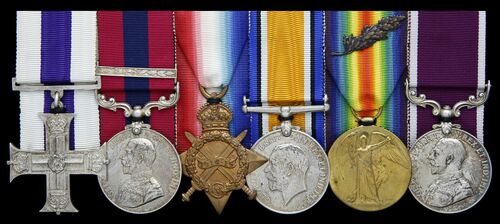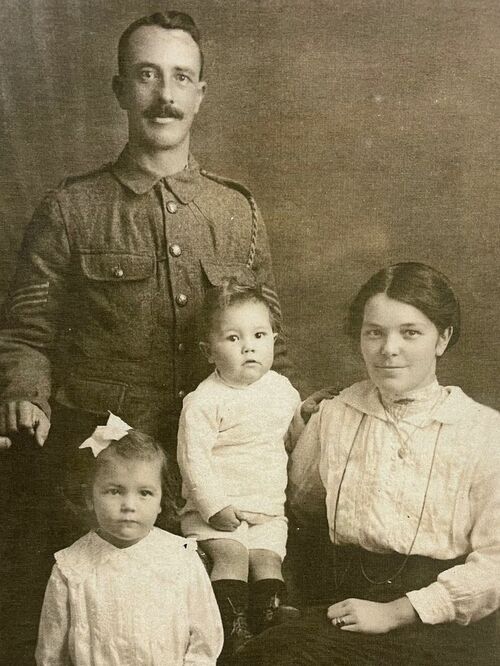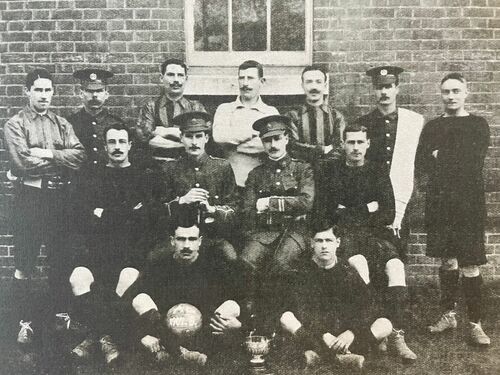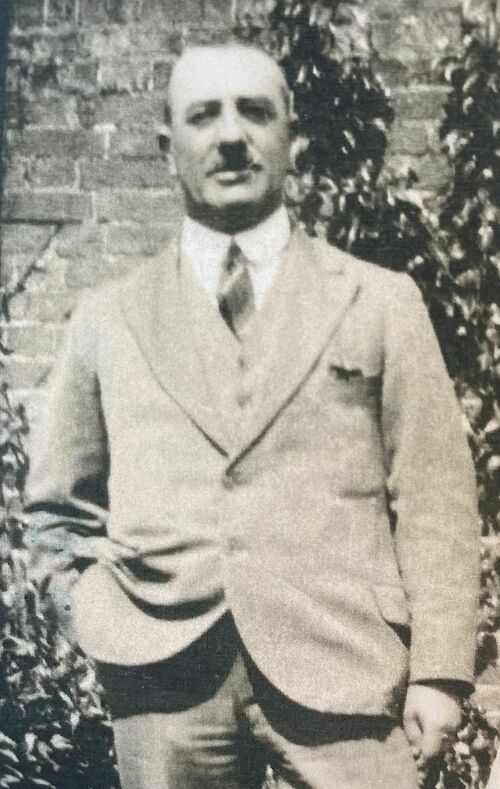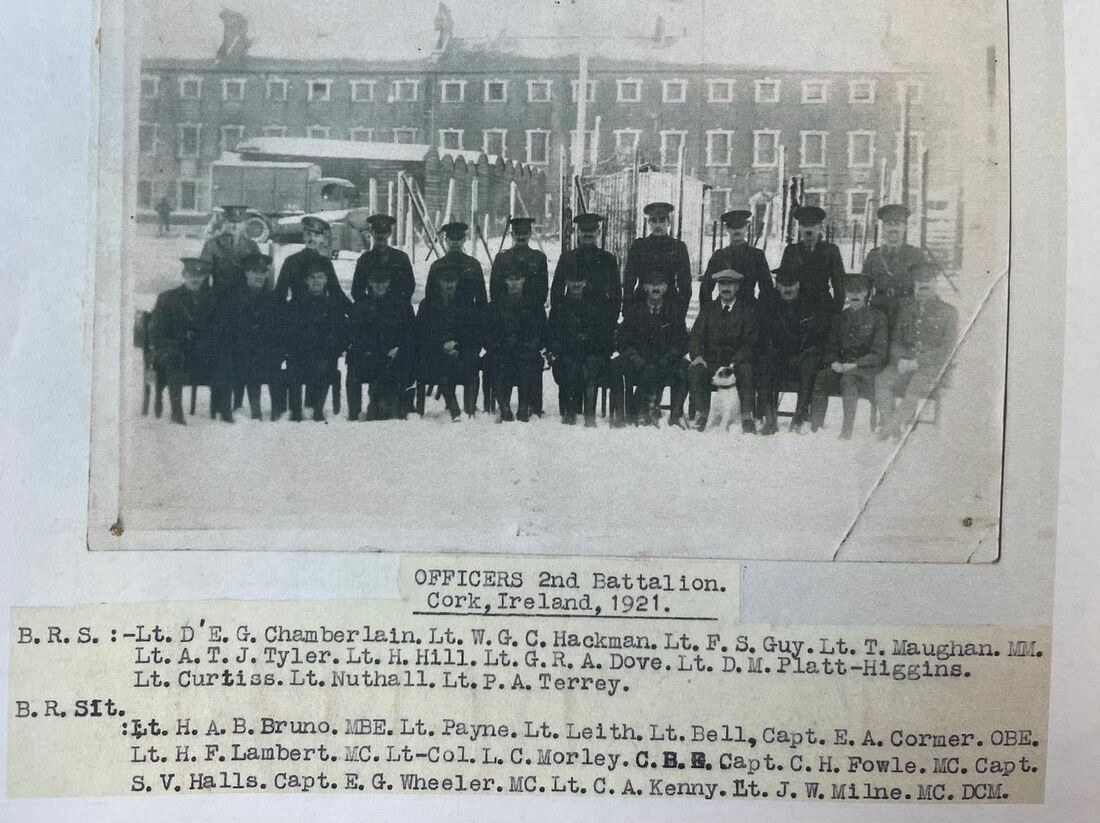Auction: 24001 - Orders, Decorations and Medals
Lot: 170
'He has always been remembered for his magnificent courage and determination in the landings at Gallipoli from the River Clyde...one of his treasured possessions was a congratulatory letter from Winston Churchill on his courage and bravery at the Gallipoli landings'.
The Royal Hampshire Regiment OCA upon the death of the gallant Captain Milne.
The remarkable - and likely unique - Great War ‘Western Front’ M.C., ‘Gallipoli’ D.C.M. and ‘Cambrai’ Bar group of six awarded to Captain, late Warrant Officer Class 1 J. W. Milne, Hampshire Regiment
A pre-War Regular, Milne was with the 2nd Battalion and landed on Gallipoli via the River Clyde on 25 April 1915, displaying remarkable bravery during the campaign, during which he earned a 'mention' and his first D.C.M., besides being severely wounded
Returned to the fold on the Western Front, he added a Bar for good measure before taking a Battlefield Commission and thence an M.C. during the Crossing of the Lys, during which General Freyberg accompanied them in the action
Military Cross, G.V.R.; Distinguished Conduct Medal, G.V.R., with Second Award Bar (5576 Sjt: J. Milne. 2/Hants: Regt.); 1914-15 Star (5576 Sjt. J. Milne. Hamps. R.); British War and Victory Medals, with M.I.D. oak leaves (Capt. J. W. Milne); Army L.S. & G.C., G.V.R. (5576 Sjt: J. Milne. Hants: R.), good very fine (6)
Approximately 472 Second Award Bars to the D.C.M. awarded during the Great War, of which just 4 went to the Hampshire Regiment, making this likely unique in combination with the Military Cross.
M.C. London Gazette 8 March 1919. The citation followed on 4 October 1919:
‘2nd Lieut. For conspicuous gallantry and devotion to duty near Courtrai. On the night of 17th Oct. 1918, during a withdrawal across the River Lys, he was the first to cross and find out the situation on the Harlebeke-Courtrai Road. He was then entrusted with the right flank of the party covering the withdrawal. His post was repeatedly attacked by enemy patrols from Courtrai and he repulsed them in every case.’
D.C.M. London Gazette 6 September 1915:
‘For conspicuous gallantry and ability during and subsequent to the landing operations on the Gallipoli Peninsula. Sjt. Milne performed consistent good work and showed the greatest coolness and bravery under hazardous conditions and at critical times. He led his platoon with great ability and judgement on several occasions and under very heavy fire, and has throughout displayed high powers of leadership and set a fine example of devotion to duty, which has given great encouragement to all with him.’
Second Award Bar to D.C.M. London Gazette 4 March 1918:
‘For conspicuous gallantry and devotion to duty in going out on his own initiative with a patrol and working his way up to a machine-gun which was causing casualties, opening fire on the gunners, and succeeded in driving them back.’
M.I.D. London Gazette 5 August 1915.
John Warsip Milne - or 'Jock' to his friends and comrades - was born on 19 June 1881 at St. Giles, Edinburgh. Having served in the Militia, he then moved to the Isle of Wight for work and was a labourer upon his enlistment into the British Army at Winchester in 1899. Whilst his early Service Records do not survive, entries in the Regimental Journal confirm his advancement to Lance-Corporal in January 1907 and Corporal in August 1910. Milne was married to Agnes Mary Coombes in June 1911 at Portsea, Hampshire, with whom he had three children. Prior to the outbreak of the Great War, he saw service on garrison duty overseas in India, Aden, South Africa and Mauritius, his second child, his daughter Flora Agnes, being born in the latter place at Curepipe on 24 April 1912. By June of 1912 he was with the 2nd Battalion and in July 1913 is identified in a photograph of the Corporal's Club of the 2nd Battalion.
Great War - Gallipoli
In August 1914 Milne was in India when stationed at Mhow, and he then returned to England with his Battalion and arrived at Plymouth on 22 December 1914, when they were moved to Romsey, and on 13 February 1915 to Stratford-upon-Avon. On this date they came under orders of the 88th Brigade in the 29th Division. Milne was promoted Sergeant, and then sailed with the 2nd Battalion from Avonmouth for Gallipoli, going via Egypt where it landed at Alexandra on 2 April 1915. It sailed again on 12 April and landed next day at Mudros on Lemnos, which was to be the advanced base for operations at Gallipoli.
The Battalion landed at Cape Helles on 25 April 1915, when Milne is confirmed as having stormed ashore as a member of 'Y' Company under Captain Addison, which company was aboard the River Clyde on this fateful day, and for part of which he earned his first decoration.
The previous day, both 'Y' and 'Z' Companies left Lemnos in the Alaunia for the depot ship Tenedos, where they transferred to the River Clyde. The two Companies of the Hampshires, Milne amongst them, were allotted to No. 3 Hold, abaft the funnel and, as one account says, '...nicely placed to have it down on them should it get hit', while the men were so tightly packed that movement and even sleep was impossible. Men were heavily laden, carrying 200 rounds, full packs, haversacks and three days' 'iron rations', a total weight of 84 lbs. Shortly before midnight, the flotilla left for the peninsula, the movements being so timed that the ships and boats with the troops and their escorting warships should be off the landing places just before dawn.
At V Beach, 300 yards of sand separate a steep cliff on the West, crowned by a fort, from the fort and the village of Sedd el Bahr on another cliff to the East. A bank about five feet in height fringes the back of the sandy strip, beyond which the ground rises to a ridge about 100 feet up. Several lines of wire stretched across this rising ground, in which were several machine-guns and pom-poms in well-sited positions, hard to locate but covering the beach and all approaching it. These the naval bombardment, even with 12-inch guns, had been powerless to silence.
As the River Clyde approached the shore she outstripped the tows and had to wait and let them get ahead, even so she had grounded 40 yards from the shore before the tows reached the beach. Almost immediately a devastating fire caught the crowded boats and within a few minutes terrible losses had been inflicted, many men being shot down before they could leave them, others were hit in the water, most of the wounded being drowned, and the few who survived to get ashore could only shelter behind the bank beyond the beach. Worse still, a hopper should have bridged the gap between the River Clyde and the shore, but it had swung away to port and failed to established the connecting link, and the men had to jump into shoulder-deep water and gave good targets as they slowly struggled shorewards. The River Clyde's Skipper, Commander Unwin, managed to get three lighters in tow on her starboard side into position to make a bridge, giving the Munsters a chance to dash along the gangways towards the shore. So murderous and accurate was the fire, mainly machine-guns, that only a handful achieved their purpose and the gangways and lighters were soon crowded with dead and wounded, while after a sailor who was helping Commander Unwin to hold the lighters in position had been killed they drifted into deep water. A few men managed to wade ashore but after No. 9 Platoon of 'Y' Company had lost its commander, Captain Boxall, mortally wounded, and nearly 20 men in a gallant attempt to get ashore, Colonel Carrington-Smith, senior officer on board the River Clyde, stopped further efforts as merely entailing useless sacrifice of life.
Meanwhile the Battalion's machine-guns on board the River Clyde under Lieutenant Rosser and some Naval Division guns were trying hard to keep down the machine gun fire and giving effective covering-fire to the men ashore, but the well-concealed Turkish guns were hard to locate and harder to silence.
The flat sweepers with the bulk of the 88th Brigade were now approaching V Beach, and such few boats as had survived the first trip took off from on of them Brigadier General Napier himself, 50 men of 'W' and 'X' Companies of the Hampshires with Captains Wymer and Spencer-Smith, and two platoons of the Worcestershires. On their coming alongside the River Clyde they were hailed and warned that it was hopeless to try and get ashore. The Brigadier, however, would not be deterred and reached the hopper, only to be shot down with Captain Costeker, his Brigade Major. This was rather before 1100hrs. His death was a great loss: very much liked and respected, he had already gained a great hold on the brigade as a leader of great character and ability. Meanwhile the boats carrying the parties under Captains Wyler and Spencer-Smith were making a dash for the shore to starboard of the collier. A burst of fire met them, but they kept on and, jumping into fairly shallow water and scrambling along a projecting spit of rock, the two officers and two-thirds of their men, joined those Dublins and Munsters who were sheltering along the bank under the Sedd el Bahr cliffs. Here they were held up, and if the Turks never attempted to dislodge them they could only hang on with hardly a chance of a target; the stalemate was complete. The naval guns might pound away but they could not get at the machine-guns which dominated the situation.
It was while trying to locate the machine-guns that, about 1500hrs, Colonel Carrington-Smith was hit and killed. He was on the bridge of the River Clyde and had just marked down one machine-gun when he was hit. He had not been long with the 2nd Hampshires, he had won the confidence and respect of officers and men, and in him the regiment lost a most competent commander who might have gone far.
At the other beaches things had gone better. Sir Ian Hamilton had directed General Hunter-Weston to divert the rest of the 88th Brigade to W Beach, where accordingly the main body of 'W' and 'X' Companies under Major Leigh landed unopposed, pushing forward to fill a gap in the line which now stretched from the light house near Cape Helles, which the Worcestershire's had taken, across by Hill 138 to Hill 114, where the W Beach troops had gained touch with the Royal Fusiliers. By the time this party was ashore the two redoubts on Hill 138 had been taken and the Hampshires merely filled a gap in the extended line of the Essex, north of Hill 138. Fighting had now died down, if there were Turks close in front of the line which was being entrenched, then an advance from this line might have relieved the remnants handing on to their precarious hold on V Beach, but the urgency of their situation does not seem to have been realised. The 86th Brigade's commander had been wounded and no senior officer was present to take charge and push on.
During the afternoon, the fire on V Beach slackened and the sailors hauled the lighters connecting the collier with the shore back in to position, whereupon the Munsters again tried a rush, only to awaken the Turkish machine-guns into renewed activity and be checked. Rather later three battleships gave the Turkish positions a fresh pounding, under cover of which a handful of Munsters and Hampshires tried to force an entrance into the Sedd el Bahr fort but without much success, having to shelter on the seaward face without getting in. Before it was dark, however, Major Beckwith went ashore to take over command and directed Captain Spencer-Smith and the 18 men left out of his 26 to push on into the fort and secure the exit from it to the north. Accompanied by some Dublins and Munsters, the party moved some way to the right, climbed the cliff, cutting many strands of barbed wire, and dashed into the fort, the Turks bolting before them. They then established themselves on the Northern face of the fort, where most of the walls were still standing, and under cover of this party, whose occupation of the fort prevented a counter-attack on that side, the remaining troops from the River Clyde crossed the gangways quite unhindered and brought welcome help to the survivors ashore. The wounded could now be succoured and removed and the troops sorted out and reorganised. To have attempted an immediate attack would have been futile, the exhausted survivors of the earlier attempts to landed wanted a rest, and Major Beckwith had to arrange with Colonels Williams and Doughty-Wylie of the G.H.Q. Staff for a fresh naval bombardment before any further advance against Sedd el Bahr and the old castle could be attempted.
The Turks made no effort to impede our preparations, if patrols and scouts more than once approached the line further west in which 'W' and 'X' Companies were stationed and disturbed their rest, already rather broken into by the need for work parties to get rations, ammunition, and water ashore. Few men had a proper night's rest on the night before landing, and their fatigue and the need for unloading supplies largely explains the scanty progress made next day by the force coving W and X Beaches. Actually very few Turks were facing them, the defenders being apparently concentrated at Sedd el Bahr to resist our renewed attacks.
At V Beach two points had to be attacked, the fort and the village of Sedd el Bahr on the east, and the old castle on Hill 141 to the north west. Nearly all the Hampshires had to be collected on the Sedd el Bahr side. Before dawn, Captain Spencer-Smith's party, who had held the ruins during the night, were withdrawn to join the rest of the Hampshires on the top of the cliff. This detachment and the machine-guns could give covering fire to the main attack, some Hampshires under Captain Penn-Gaskell working through a gap which had been cut in the wire, were to attack the west of the fort, the rest, together with some Munsters, after re-occupying the fort were to press forward against the village. These preparations were difficult to make in the dark, especially as many wounded had to be got away and a tangle of wire impeded movement.
Shortly before dawn (April 26th) the supporting ships opened fire again but directed their fire more against the village than against the fort. This led to some delay but eventually the attack went in, the fort being quickly cleared. In debouching beyond it by a narrow postern gate the troops came under accurate fire from trenches on the edge of the cliff and were checked. However, Major Beckwich soon had the advance going again and, headed by Captain Addison and by Captain Walford of the G.H.Q. staff, 'Y' Company (with Milne a part) forced their way into the village, the machine-guns covering their advance. In the village they met desperate resistance; the Turks contesting every house and had to be ousted with the bayonet from one after another. Some lay quiet, concealed in cellars or ruins, till our men had passed by and then fired into their backs. Machine-gun and rifle fire from Hill 141 was troublesome and, with the snipers very hard to dislodge, it took nearly three hours before the Hampshires finished clearing the village. Major Beckwith's gallantry and inspiring leadership were outstanding and made a tremendous impression on the men. It was largely due to his leading that Sedd el Bahr was taken, he exposed himself recklessly and how he escaped being hit was a marvel. Captain Addison, who vied with him in leading the attack, was less fortunate, being killed by a bomb.
The fight for Sedd el Bahr finished with a charge against some trenches beyond the village, for which every available man had been collected, including Captain Spencer-Smith's party from the right. Major Beckwich himself headed the charge, brandishing an axe with which he had just cut a cable, leading, it was thought, to Kum Kale. This charge sent the surviving Turks flying, severing being shot down as they bolted. Pressing on, the Hampshires cleared a row of windmills on a hill overlooking Morto Bay and started to consolidate. Meanwhile, more to the left, where Colonel Williams had been organising the attack Dublins and Munsters with the two Hampshire platoons under Captain Penn-Gaskell were having hard fighting for the old castle: the enemy's resistance was obstinate and it took some time before the final attack could be launched. Enfilade fire from the village by which a Major of the Dublins was killed, had been troublesome, but about 1430hrs Captain Penn-Gaskell could start the final charge which carried the position, when the surviving defenders, in making off northward, gave good targets to the Hampshire's machine-guns with which Sergeant Jackson had been giving an effective covering fire. Touch was now gained with the troops at W Beach and a continuous line was established from Sedd el Bahr to X Beach, "Y" and "Z" Companies being on the right on the cliff edge beyond Sedd-el-Bahr, while "W" and "X" were well away to the left between Hills 138 and 114.
Sedd el Bahr had cost the Hampshires nearly 60 casualties, 2/Lts. Harland and Gillett being wounded. The fighting had been fierce, and if wisdom after the event suggests that the rest of the Division might have advanced at any time during the day without meeting serious opposition, the men were short of sleep and rest, water was short and the information available about the general position scanty and inaccurate. The stubbornness of the opposition had concealed its weakness and, as things appeared at the time, it seemed reasonable to wait for the French, who only started to land late in the afternoon. The French coming ashore also delayed a further advance until the afternoon of 27 April. Major Beckwith's wing, including "Y" Company, was moved from V Beach to rejoin the other companies of the 2nd Battalion, and late in the afternoon the advance resumed, the troops crossing the saucer like depression draining into Morto Bay and beginning to ascend the long slopes leading to Achi Baba. The 88th Brigade in the centre, except for a little shell fire the advance was unopposed. After advancing about 200 yards, a line was taken up running westward from at the position at de Tott's Battery across 500 yards to a point beyond the mouth of a big ravine, later known as Gully Ravine, the Hampshires being astride the road leading to Krithia. Once again, no serious attack was made by the Turks during the night, and several small advances, mostly against "Z" Company, were easily stopped.
A rather disturbed night however did not give the men much rest, and most of them started the next day's advance on 28th April, hardly fit for strenuous work. However, the attack started quite well, the Turkish outposts falling back in disorder, and at first their shell-fire was negligible, if we had too few guns ashore to give really effective artillery support. The thick scrub made the Turks hard to locate, and gullies and small ravines provided admirable natural cover, of which the enemy made good use. The men pressed on, however, and the leading platoon was under a mile from Krithia before the Turks were seen advancing to meet us.
About 1130hrs a counter-attack in force checked the French attack, but the Hampshire machine-guns well handled by Corporal Stone, helped to stop its progress. The machine gun fire also checked the advance against the Hampshires, but lack of ammunition meant that they could not maintain their position, and by 5 p.m the troops were all back where they had started. The 2nd Battalion's casualties had however been heavy, with 100 men killed and missing and 250 wounded. Major Deane, the Battalion's CO, had been killed whilst storming two Turkish trenches, and Major Beckwith, who had again rallied and led the men splendidly, had been wounded, as was Captain Spencer-Smith. 28 April would become known as the First Battle of Krithia.
After a quiet day on 29 April, about noon the following day the Battalion was relived by the French, and went back to Morto Bay for the briefest of rests. It was felt that the 29th Division was exhausted, and if a fresh division had been used, then Achi Baba may well have been taken on 28 April. As it was it was not, and this therefore failed to exploit any success achieved in the initial landings.
By 0400hrs on 1 May, the unit replaced the Essex in the front line, between the track leading to Krithia on the right, and the Kirte Dere or Krithia Nullah on the left. That evening after a heavy bombardment, the Turks attacked in force, but firing steadily with great effect, the Hampshires held up the attack, despite once incident where they penetrated the Hampshire's support trench and after some subterfuge, killed Major Leigh, the acting commanding officer, and Captain Reid, the Adjutant. Command devolved to Captain Wymer with Lt. Rosser as Adjutant. Daylight revealed Turkish bodies lying thickly in our front, at least 400 could be counted within sight of the line.
This encouraged those in command to order another general advance, and at 1000hrs on 2 May, the Hampshire's started forward. Heavy shrapnel fire met them at once but did not stop them, and they had covered nearly 1200 yards, capturing a good many Turks who were sheltering in holes and hollows, pinned to the ground by our fire. Here they held on, but a general retirement by the French on the right left them exposed, and they had to retreat, with eventually no ground having been obtained, and with once again serious casualties, 22 other ranks killed and missing, and three officers and 87 men wounded, leaving them the weakest battalion in the 88th Brigade, with little over 400 men all told left to fight. But the enemy had lost heavily and the brigade had taken over 300 prisoners.
Three fairly quiet days followed, one in the trenches consolidating, and two in reserve near Morto Bay, when for the first time since the landing a wash and shave were possible, then on 6 May another advance was attempted. The 88th Brigade with the 2nd Hampshires formed the left centre, and had to advance up a spur between the Krithia Nullah and Gully Ravine which was dotted with clumps of firs and consequently christened 'Fir Tree Spur'. Its aim was to capture Krithia and then to wheel round to the right and secure a position facing Achi Baba from the west, through which the 87th and Indian Brigades would deliver the final assault.
If the troops had started tired on the 28 April, they were little fresher now. Few officers and men had had any real rest since the initial landings, few had had change of clothes or many chances to wash. One officer wrote that '...officers and men have lived like animals, no blankets or kits, no clothes off at night, not even boots, feeding from hand to mouth and snatching sleep when we can.'
In this fresh attempt on 6 May, the 88th Brigade had the Worcestershire on the right, then the Hampshire, with the Royal Fusiliers beyond them, reaching to Gully Ravine. A screen of scouts headed the advance, which worked slowly forward for several hundred yards before opposition, largely from machine-guns in advanced posts, began to be serious. On neither flank were troops coming forward owing to opposition. Some of the 88th Brigade reached Fir Tree Wood but failed to clear it, and the line came to a halt about 500 yards from its starting line, with the Hampshires west of Fir Tree Wood; they and the Royal Fusiliers beyond them might have been able to get forward but that, being ahead of the troops on Gully Spur, they were liable to be enfiladed from across the ravine. They could only dig in where they were to secure what ground had been gained. Casualties had not been heavy, the Hampshire returning six killed and 53 wounded. Of the eight officers present in this attack, two more were unfortunately wounded, namely Captain's B.S. Parker, and Penn-Gaskell.
One of those 53 men would however was Sergeant Milne of "Y" Company, he having received a shrapnel wound to his back on the righthand side on 6 May. Evacuated aboard a hospital ship, some two days later he was admitted to No. 19 General Hospital at Alexandria on 8 May and would spend the next 71 days under treatment and recuperating, before being discharged to a convalescent camp on 17 July 1915.
In his absence, Milne's Battalion had once again gone into the attack on 8 May, but was checked somewhere north west of Fir Tree Wood, with a further 28 casualties including one officer, Captain Hudson, killed and missing, an Captain Day and 97 men wounded. This left only four officers and 204 men so-called for duty, a remnant who badly needed the weeks rest they were then given. In little over a fortnight up to 14th May, three-quarters of the battalion had become casualties, with eleven officers killed, twelve wounded and one invalided; and 198 others ranks killed, missing and died of wounds, and 507 wounded.
The operations of 6-8 May 1915, which became known as the Second Battle of Krithia, ended a definite phase of the Gallipoli venture, the attempt to rush the defences at the southern end of the peninsula and so assist the fleet to force its way through the Dardanelles.
Milne does not appear to have returned to Gallipoli, but his 'mention' and first D.C.M., to go with his wound, were hard-earned.
Second Innings
Milne appears to have returned to England for further treatment, being admitted to the Eastbourne Hospital on 22 August 1915, owing to further treatment to a gunshot wound to his back and side, and he was then discharged from hospital on 4 September 1915. He was still in England and serving with the 3rd Reserve Battalion on the occasion that the D.C.M. was presented to him by the General Officer Commanding the British Army, Field Marshal the Viscount French, at Portsmouth on 29 January 1916.
In March 1916 the 2nd Battalion had arrived on the Western Front, having sailed from Egypt, it having been finally evacuated from Gallipoli in January 1916. On the Western Front it continued to serve as part of the 88th Brigade in the 29th Division. It is unclear when Milne rejoined the 2nd Battalion, however according to the National Roll of the Great War he '...played a conspicuous part in the Battles of the Somme, Ypres and Cambrai' and was awarded his L.S. & G.C. in October 1917.
Around this time he was out on the Western Front and as such found himself involved in the Battle of Cambrai. It was for his gallantry on the first day of the Battle of Cambrai, 20 November 1917, whilst in action at Masnieres that he won the Second Award Bar to his D.C.M. when a Warrant Officer 2nd Class and Company Sergeant-Major.
The object of the Battle of Cambrai was to breech the German defensive system known as the Hindenburg Line. For the attack the 2nd Battalion was to be in the 88th Brigade's assembly area at Gouzeaucourt in readiness for zero hour, which was to be 0625hrs, just an hour before sunrise, and a thick autumn mist helped to conceal things even after it began to grow light. The German guns did not open up, even the noise made by nearly 400 tanks had actually escaped notice. Complete surprise had been achieved.
The 29th Division was initially held in reserve, but then advanced, the 88th Brigade being on the right in 'diamond' formation. Moving right in a north easterly direction, the objective of 88th Brigade, and therefore the 2nd Hampshires, was Masnieres, with the battalion bringing up the rear in the attack. In the Brown Line, the second objective, a formidable 'strong point' at Good Old Man Farm was still resisting, and whilst the Essex Regiment dealt with it, "Y" Company of the 2nd Hants had a little 'show' of its own, mopping up some 'strong points' most successfully and taking 40 prisoners.
Re-forming to continue the advance, Lieutenant-Colonel Johnston noticed that it was going too far to the left, so he brought the companies across to the right to recover the true line. Meanwhile the Worcestershires had got up level with the Essex Regiment and were approaching the canal, making for a lock half a mile south east of Masnieres. This they secured, and two Companies crossed over, while another wheeled towards Les Rues Vertes to try to secure the main bridge by which the Cambrai road crosses the canal from Les Rues Vertes to Masnieres. This the Essex should have taken, but they had diverged to the left and the Germans had had time to demolish it partially, and what they had not finished a tank now completed for them. This prevented the cavalry pushing through to secure a hold in the Masnieres-Beaurevoir Line, which the supporting infantry might exploit. Indeed, when the Hampshire came up the Brigade seemed to be checked, though before long some of the Worcestershires had reinforced the Essex and were forcing their way in to Les Rues Vertes, and the Newfoundlanders were reaching the canal bank west of Masnieres.
Johnston's first intention was to press the attack against the main road-bridge, and "Y" pushed ahead to do this, "X" and "Z" following, while "W" cleared some houses along the main road. However, he now learned from a Tank officer that the bridge was impassable, so he diverted "W", "X", and "Z" to the right to cross at the lock and reinforce the Worcestershire, leaving "Y" under Captain Bircham to help clear Les Rues Vertes and secure our end of the bridge. Unfortunately, as the lock had to be crossed in single file under machine-gun fire and sniping, it was 1500hrs before its passage was completed.
Lieutenant-Colonel Linton of the Worcestershires having been killed, Johnston took command of the troops across the canal and sent "X" Company against Masnieres, while "W" and "Z", attacking on the Worcestershires left, helped them to capture Mon Plaisir Farm and make a lodgement in the Masnieres-Beaurevoir Line, between the lock and the north west corner of Masnieres. In this stage of the fight Captain Ashling led "Z" very skilfully and established it in a good position, while Captain Lord took command of officer less men and led them on to the objective, whose consolidation he directed, besides organising and leading an attack on a 'strong point' for whose capture he was largely responsible. Thus a good position was established, Johnston making very skilful dispositions, going far to secure the right flank of the brigade line. "Y", having cleared Les Rues Vertes, rejoined and was placed in reserve at the lock, and "X", after clearing the outskirts of Masnieres, formed a defensive flank facing that village.
During the night orders were received that Masnieres must be cleared as a preliminary to further efforts against the Beaurevoir Line, so "W" and a Company of the Worcestershires were detailed for this task. This took some time, the Germans resisting stubbornly, but by 0430hrs the next morning (21 November) the village had been practically cleared but for a dug-out below the church which held on for some time longer, so the troops who had done the work could advance against the Masnieres-Beaurevoir trenches across the Cambrai road, which was reported not to be strongly held.
It was for his gallantry in action, when most probably serving within "X" Company, that Milne was awarded the rare Second Award Bar to his D.C.M.. In all the 2nd Battalion, which suffered some 350 casualties during the Battle of Cambrai from 20 November-December 1917.
Milne was Warrant Officer 2nd Class and Company Sergeant Major at this time, was promoted to Warrant Officer 1st Class (Regimental Sergeant-Major) at some stage, and remaining with the 2nd Battalion, was then granted a commission in the field as 2nd Lieutenant on 3 June 1918.
It was during the final advance near to Courtrai when involved in a withdrawal over the river Lys that he won his final decoration of the Great War. The Lys had been crossed on 16 October, and a precarious foothold obtained by men of the 9th Division. The bridges connecting the advanced detachments with the left bank were under shell-fire and were so repeatedly hit, far from more being constructed, those already laid were rendered useless. The Germans were also counterattacking to throw the British back over the river. With the bridges virtually demolished, it was clear that the advanced detachments could not be supported, and after Brigadier-General Freyberg had himself come across to investigate orders were given to withdraw them. To cover the operation a selected party of Hampshire Lewis gunners was ferried across in pontoons, so quickly and silently, that though the night was bright, the enemy never detected the move. This party having taken up its covering positions, the 9th Division's men were safely withdrawn, all their wounded being brought away, after which the Hampshire covering party was also ferried back, General Freyberg and Colonel Westmorland only leaving with the rear-party under 2nd Lieutenant Milne.
Milne returned to England on 12 December 1918 as an escort for the Regimental Colours and was then present in the ceremony in which His Majesty the King of the Belgians re-took the throne in the aftermath of the German occupation. Milne was promoted Captain on 14 December 1918 whilst commanding a Company. During 1919, Milne is understood to have seen service in Russia, returning to England in November of that year, he then also saw service briefly in Ireland at the time of the Irish Civil War. After a period as a recruiting officer, Milne then returned to the 2nd Battalion as the Assistant Adjutant from 1 August 1920. Transferred to the Regular Army Reserve of Officers on 26 October 1922, he was discharged from the Reserve on 31 March 1931, whilst in the meantime becoming a business owner and running a boot repairing business in Portsmouth. Milne was committee member of the Portsmouth Branch of the Royal Hampshire Regiment Old Comrades' Association. He died in August 1952.
Subject to 20% VAT on Buyer’s Premium. For more information please view Terms and Conditions for Buyers.
Sold for
£8,500
Starting price
£6000

